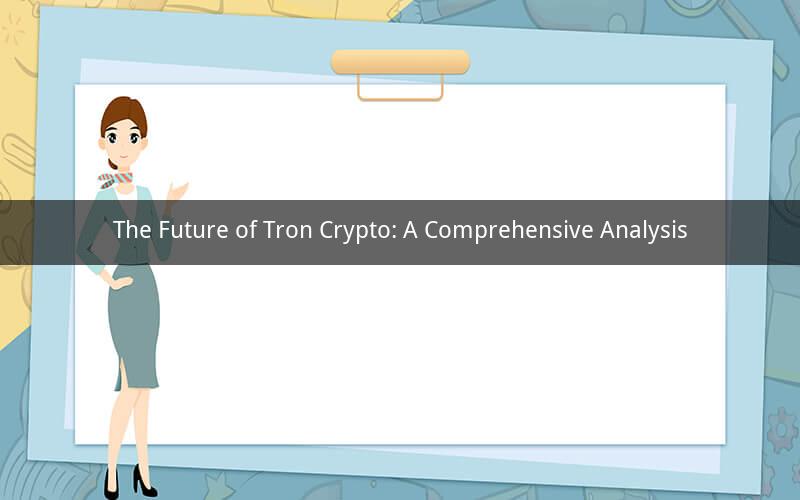
Tron, a blockchain platform founded by Justin Sun, has been making waves in the crypto world since its inception. With its ambitious goals and innovative features, many are left wondering: does Tron crypto have a future? This article delves into the various aspects of Tron and its potential for growth in the years to come.
1. The Vision Behind Tron
Tron aims to become a decentralized entertainment platform that enables content creators to have full control over their digital assets. The platform's native token, TRX, is designed to facilitate transactions and incentivize users to participate in the network. With a strong focus on entertainment and content creation, Tron has the potential to disrupt various industries.
2. The Tron Blockchain
The Tron blockchain is built on a unique consensus algorithm called DPoS (Delegated Proof of Stake). This algorithm allows for faster transaction speeds and lower fees compared to traditional Proof of Work (PoW) blockchains. By utilizing DPoS, Tron can handle a higher throughput of transactions, making it suitable for applications requiring a high level of scalability.
3. The Tron Ecosystem
Tron has built a robust ecosystem that includes a decentralized exchange (TRXMarket), a decentralized wallet (TronLink), and a content delivery network (TronGrid). These tools help facilitate the seamless transfer of digital assets and content across the platform. Moreover, the Tron ecosystem encourages collaboration between content creators and developers, fostering innovation and growth.
4. The Competition
Tron faces stiff competition from other blockchain platforms, such as Ethereum and Binance Smart Chain. Ethereum, being the pioneer in smart contracts, has a strong developer community and a vast array of decentralized applications (dApps). Binance Smart Chain, on the other hand, boasts high scalability and low transaction fees, making it an attractive platform for developers.
Despite the competition, Tron has managed to carve out a niche for itself by focusing on entertainment and content creation. Its strong partnerships with major entertainment companies and its commitment to user-centric solutions have helped establish its presence in the crypto world.
5. The Regulatory Landscape
The regulatory landscape remains a significant challenge for Tron and other blockchain platforms. Governments around the world are still figuring out how to regulate cryptocurrencies and ensure consumer protection. Tron has taken steps to comply with regulations, such as obtaining a license in Singapore and working with financial institutions to facilitate the integration of TRX into traditional finance.
6. The Future of Tron Crypto
The future of Tron crypto depends on several factors, including its ability to innovate, its partnerships, and the regulatory environment. Here are some potential scenarios:
a. Tron could become the go-to platform for content creators and entertainment companies, leading to exponential growth in its user base and token value.
b. Tron may face challenges in scaling and interoperability, causing it to lose market share to more advanced platforms like Ethereum and Binance Smart Chain.
c. Regulatory pressures could force Tron to adapt its business model, potentially affecting its growth and adoption.
d. The Tron ecosystem could expand beyond entertainment, attracting developers and businesses from various industries, leading to a diversified and robust platform.
e. Tron may fail to gain traction and fade into obscurity, becoming just another failed crypto project.
In conclusion, while the future of Tron crypto is uncertain, its potential is undeniable. With a strong focus on entertainment and content creation, a robust ecosystem, and a visionary founder, Tron has the ingredients for success. However, the challenges it faces, including competition and regulatory hurdles, cannot be overlooked. Only time will tell if Tron can realize its full potential.
Questions and Answers:
1. What is the main focus of Tron's blockchain platform?
Answer: Tron's main focus is to become a decentralized entertainment platform that enables content creators to have full control over their digital assets.
2. How does Tron's DPoS consensus algorithm differ from traditional PoW algorithms?
Answer: Tron's DPoS algorithm allows for faster transaction speeds and lower fees compared to traditional PoW algorithms, making it more scalable for applications requiring high throughput.
3. What is the role of TRX in the Tron ecosystem?
Answer: TRX is the native token of the Tron blockchain and is used to facilitate transactions and incentivize users to participate in the network.
4. How does Tron plan to comply with regulatory challenges?
Answer: Tron has taken steps to comply with regulations, such as obtaining a license in Singapore and working with financial institutions to facilitate the integration of TRX into traditional finance.
5. What are the potential scenarios for the future of Tron crypto?
Answer: The potential scenarios for the future of Tron crypto include exponential growth, losing market share, adapting to regulatory changes, expanding beyond entertainment, and fading into obscurity.